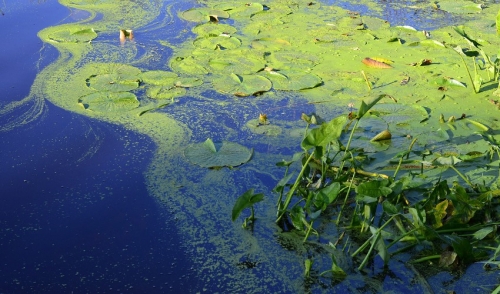Algae is a natural part of any backyard pond and helps balance the pond's chemical composition and feed the fish, ducks and insects that rely on the pond's ecosystem. Too much algae, however, can overwhelm a filter, generate an unpleasant smell and decrease water clarity with cloudy, murky or colored water. While it is common for new ponds to develop problems with algae and poor water clarity, every pond is different and it is easy to control algae and improve water clarity.
Controlling Algae
There are several ways to minimize pond algae and maximize water clarity…
- Minimize Runoff: If sprinklers or storm runoff flows into the pond, the extra water can upset the pond's chemical balance and may carry chemicals or debris which will encourage algae. Contour the edges of the pond to minimize runoff and adjust sprinklers to avoid the pond.
- Skim Debris Regularly: When leaves, flower petals, feathers and other debris falls onto a pond, it will eventually become waterlogged and sink, adding to the organic material in the pond and decaying, discoloring the water and providing nutrients for algae. Skimming the pond will remove much of this debris.
- Use the Proper Equipment: If the pond's pump and filter are too small, they will be inadequate to remove unnecessary organic material and debris, resulting in more algae and less clear water. If necessary, upgrade the equipment to the proper size and durability to handle the pond's volume, ideally circulating 50-100 percent of the water through the filter each hour.
- Add Plants: Water lilies and other pond plants are more than just decorations; they absorb nutrients from the water that would otherwise feed algae. Adding more plants to the water will provide additional natural filtration to keep the water fresh and clear.
- Feed Fish Properly: If the pond contains koi or other fish, do not over feed them. Uneaten food will rot at the bottom of the pond, encouraging more algae growth and discoloring the water. Research the proper amount of food for the fish and only offer what they need, no matter how much they may beg for treats.
- Shade the Water: Algae needs abundant sunlight for profuse growth, and shading at least a portion of the pond will cool the water and make it less algae-friendly. A rock overhang or crossover bridge will also provide a hiding place for any fish and can be an attractive decoration.
- Add Aeration: Aerated water has a higher oxygen concentration that helps inhibit algae, and the agitation of moving water can disrupt algal growth. A fountain or waterfall can be an attractive part of any backyard pond and will help preserve water clarity.
- Vacuum the Pond: Removing organic debris from the pond's bottom is a critical step for discouraging algae and enhancing water clarity. Underwater vacuums are effective if the bottom of the pond is relatively level and free of small rocks, otherwise it may be necessary to periodically drain the pond to remove accumulated debris. A layer of a quarter inch is no problem for most ponds, but if debris accumulates any deeper, murky water and more algae will be the result.
Pond owners should expect some algae in any pond, but it is easy to minimize excessive algae growth to maximize water clarity for a clear, lovely pond that is a tranquil backyard oasis.


Comments